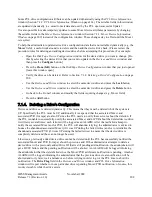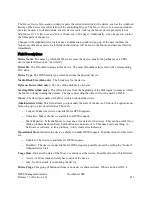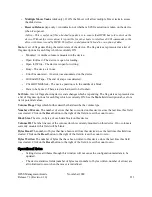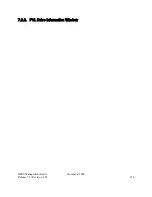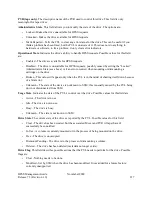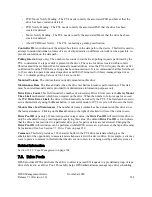
and thus availability. To do this, the HPSS administrator will need to:
•
Associate tape drives to a specific drive pool by configuring the HPSS tape drives with a non-zero
positive integer
Drive Pool ID
.
•
Modify the end client to dictate that their read request be serviced by tape drives from this
particular Drive Pool.
7.3.1. Tape Drive Configuration
To associate HPSS tape drives to a specific drive pool, an HPSS administrator will need to configure
HPSS tape drives with a non-zero positive integer
Drive Pool ID
. The
Drive Pool ID
can be set at
configuration time via the
Tape Device Configuration
window (Section 7.1:
Configure a New Device &
Drive
on page 196); it can be dynamically modified during runtime via the
PVL Drive Information
window (Section 7.2.2:
PVL Drive Information Window
on page 214) as long as the tape drive is locked
and free. To change the value during downtime, you must use the
Tape Device Configuration
window
and take down the HPSS servers associated with the tape drive: Mover, PVL and PVR. A
Drive Pool ID
of zero indicates the default Drive Pool.
7.3.2. Client Application Tape Read Requests
To make use of the Drive Pool feature, HPSS end client applications will need to be modified to dictate
that their read request be serviced by tape drives from this particular Drive Pool. This ability is only
available via the hpss_ReadList() API. The
Drive Pool ID
must be specified in the
ReqSpecInfo
structure
of the I/O Descriptor (IOD) passed to hpss_ReadList. This is accomplished by specifying
HPSS_IOD_SUBFUNC_DRIVE_POOL for the
SubFunction
and the
Drive Pool ID
for the
Argument
in
the
ReqSpecInfo
structure of the IOD. Refer to the
HPSS Programmer's Reference - I/O Supplement
for
more information.
7.3.3. Drive Pool Considerations
If HPSS receives an invalid
Drive Pool ID
or if the requested
Drive Pool ID
does not have the
appropriate drive type to handle the request, then the HPSS Client API will return an error to the client
for retry.
Since the
Drive Pool ID
is only used for read requests, all tape writes and tape migrations will use the
default
Drive Pool ID
. It is recommended that at least one tape drive remain in the default drive pool at
all times in order to satisfy these tape write requests.
Drive pool scheduling may not occur immediately since it could be the case that the drive was already
scheduled before the drive was locked and the
Drive Pool ID
was changed.
If a tape is being read and a request to read the same tape arrives within 45 seconds after the first request
completes, the Core Server will issue the I/O to the existing cartridge/drive. Once the drive transitions to
the Deferred Dismount state, a second request with a different
Drive Pool ID
will result in a dismount
and mount to a drive with the assigned
Drive Pool ID
.
Clients specifying different
Drive Pool ID
s for accesses to files from the same tape (or set of tape) may
result in more tape mount/unmount activity, depending upon timing. This is another reason why the drive
pool processing is restricted to tape read access only.
All mounts for striped tape volumes will be serviced from the same Drive Pool.
HPSS Management Guide
November 2009
Release 7.3 (Revision 1.0)
219
Summary of Contents for RELEASE 7.3
Page 14: ...HPSS Management Guide November 2009 Release 7 3 Revision 1 0 14...
Page 195: ...HPSS Management Guide November 2009 Release 7 3 Revision 1 0 195...
Page 210: ...HPSS Management Guide November 2009 Release 7 3 Revision 1 0 210...
Page 215: ...HPSS Management Guide November 2009 Release 7 3 Revision 1 0 215...
Page 222: ...HPSS Management Guide November 2009 Release 7 3 Revision 1 0 222...
Page 266: ...HPSS Management Guide November 2009 Release 7 3 Revision 1 0 266...
Page 293: ...HPSS Management Guide November 2009 Release 7 3 Revision 1 0 293...
Page 367: ...HPSS Management Guide November 2009 Release 7 3 Revision 1 0 367...
Page 372: ...HPSS Management Guide November 2009 Release 7 3 Revision 1 0 372...
Page 384: ...HPSS Management Guide November 2009 Release 7 3 Revision 1 0 384...
Page 388: ...HPSS Management Guide November 2009 Release 7 3 Revision 1 0 388...




